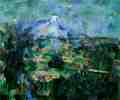![]()
 Le Mont Sainte-Victoire vu des Lauves
Le Mont Sainte-Victoire vu des Lauves
1904-06 (190 Kb); Mont Sainte-Victoire Seen from Les Lauves; Oil on canvas, 60 x 72 cm (23 5/8 x 28 3/8 in); Kunstmuseum, Basel; Venturi 1529
Joachim Gasquet's recollections of Cézanne, put down many years after the painter's death, do not always inspire confidence. The poet's innate verbosity often transformed Cézanne's occasionally quite awkward words into an insufferably literary style. Yet, despite such shortcomings, Gasquet does seem to have caught some of the artist's expressions when he transcribed a conversation with him in front of a motif (which, incidentally, was not this one):
'You see, a motif is this...' (He put his hands together, drew them apart, the ten fingers open, then slowly, very slowly brought them together again, clasped them, squeezed them tightly, meshing them.) 'That's what one should try to achieve. If one hand is held too high or too low, it won't work. Not a single link should be too slack, leaving a hole through which the emotion, the light, the truth can escape. You must understand that I work on the whole canvas, on everything at once. With one impulse, with undivided faith, I approach all the scattered bits and pieces. Everything we see falls apart, vanishes, doesn't it? Nature is always the same, but nothing in her that appears to us, lasts. Our art must render the thrill of her permanence along with her elements, the appearance of all her changes. It must give us a taste of her eternity. What is there underneath? Maybe nothing. Maybe everything. Everything, you understand! So I bring together her wandering hands. I take something at right, something at left, here, there, everywhere, her tones, her colors, her nuances, I set them down, I bring them together. They form lines. They become objects, rocks, trees, without my planning. They take on volume, value. If these volumes, these values, correspond on my canvas, in my sensibility, to the planes, to the spots which I have, which are there before our eyes, then my canvas has brought its hands together. It does not waver. The hands have been joined neither too high nor too low. My canvas is true, compact, full. But if there is the slightest distraction, if I fail just a little bit, above all if I interpret too much one day, if today I am carried away by a theory which runs counter to that of yesterday, if I think while I paint, if I meddle, whoosh! everything goes to pieces.
'The artist is no more than a receptacle for sensations, a brain, a recording apparatus. But if it interferes, if it dares, feeble apparatus that it is, to deliberately intervene in what it should be translating, its own pettiness gets into the picture. The work becomes inferior.
'Art is a harmony parallel to nature. What can we say to the fools who tell us: the painter is always inferior to nature? He is parallel to her. Provided, of course, he does not intervene deliberately. His only aspiration must be to silence. He must stifle within himself the voices of prejudice, he must forget, always forget, establish silence, be a perfect echo. Then the landscape will inscribe itself on his sensitive tablet. In order to record it on the canvas, to externalize it, his craft will have to be appealed to, but a respectful craft which also must be ready only to obey, to translate unconsciously--so well does it know its language--the text it is deciphering, the two parallel texts, nature as seen, nature as felt, the one that is there... (he pointed to the green and blue plain), the one that is here... (he tapped his forehead), both of which must merge in order to endure, to live a life half human, half divine, the life of art, listen to me... the life of God.'